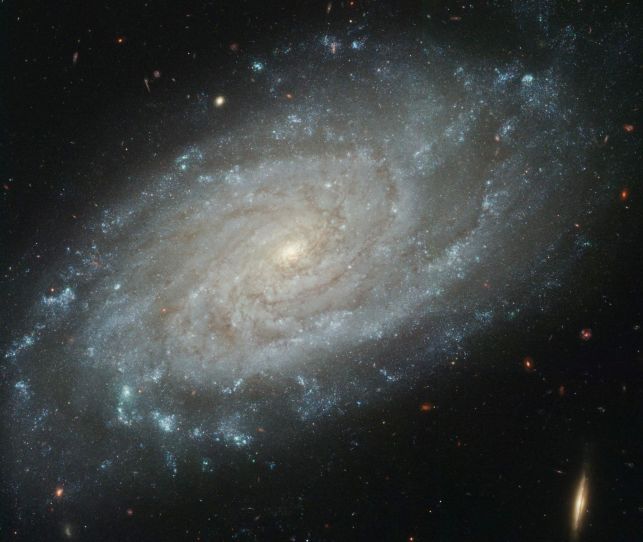Subscribe to receive new posts:
Posts Tagged ‘astronomy’
An Earth-like Exoplanet, Extraterrestrial Life and the Messianic Age
The most Earth-like planet yet discovered has been found right in our neighborhood according to a report in an April 18, 2014 issue of the L.A. Times from the journal Science. By sifting through observations from more than 100,000 distant stars, astronomers say they have discovered the first definitive Earth-sized planet that orbits in a habitable zone where water could exist in liquid form — a necessary condition for life as we know it.
Scientists don’t know whether the planet has water or a protective atmosphere. But they said the landmark discovery gives astronomers great hope that a bumper crop of Earth-like planets is waiting to be found nearby. “This is really a tip-of-the-iceberg discovery,” said Jason Rowe, an astronomer who spent a year analyzing data gathered by the Kepler space telescope.
The planet is 10% bigger than Earth, and its parent star is a red dwarf, smaller and dimmer than our sun but that is good news because red dwarfs are the most common star in our galaxy. UC Berkeley astronomer Geoffrey Marcy, who discovered the first exoplanet said. “This is the best case for a habitable planet yet found. The results are absolutely rock solid.” read more
New Planets, A God For The Cosmos and Exotheology
We are blessed to live in an age of great discoveries. Prior to about fifteen years ago, astronomers had not been able to identify planets in orbit around stars beyond our solar system. These planets, known as extra solar planets or exoplanets, have now been found. In fact, in the first dozen years from the discovery of the first exoplanet, about 500 such planets were located in diverse areas of the known universe.
Then NASA initiated the Kepler space mission, which was designed to find Earth sized planets within the habitable zone of a star. The mission focused on a relatively small star field in the constellations Cygnus and Lyra, perhaps the extent of the sky obscured by an average extended fist. The discoveries have been phenomenal, and the pace seems to be accelerating. As science writer Timothy Ferris has said, “We live in a changing universe, and few things are changing faster than our conception of it.” (Ferris, The Whole Shebang (Simon & Schuster 1997), at 11.) read more
Science and Judaism: WWMD? What Would Maimonides Do?

Credit: NASA AS8-14-2383
Rabbi Moshe ben Maimon, Maimonides, also known by the acronym Rambam, lived just over eight hundred years ago (1138-1204 CE). He never saw the planet Earth as astronaut William Anders did on December 24, 1968 when module pilot Anders took the now iconic photograph above while flying over the lunar surface during the first manned orbit of the Moon. We do not know if Maimonides even imagined such a sight.

Credit: NASA/JPL P41508
The picture above shows Earth with the Moon in the background. This scene was captured by the Galileo Orbiter on December 16, 1992 at a distance of almost four million miles from our home planet. Maimonides never had the opportunity to see Earth and Moon from this perspective either.
Credit: NASA, The Hubble Heritage Team and A. Riess (STSci). PRC2003-24.
Living some four hundred years before Nicolaus Copernicus considered the nature of the solar system and Galileo Galilei fashioned his first telescope, Maimonides did not realize that the Earth circled the Sun, and not the other way around as was commonly understood in his day. Nor could he have known that the Sun was but one medium sized star in a rather unremarkable galaxy known as the Milky Way which spans 100,000 light years and is similar in size and shape to the spiral galaxy NGC 3370 shown above in a picture taken by the Hubble Space Telescope. Similarly, he would not have known either that our galaxy consisted of a few hundred billion stars, give or take, or that the Milky Way was but one of perhaps a hundred billion galaxies, give or take, in the visible universe. See Tyson and Goldsmith, Origins (W.W. Norton, 2005), at 27, 150. read more
The Wise Scientists of Chelm and the Setting of the Sun

Credit: ESA/NASA/SOHO (Published 2/17/2011)*
Some time ago, in the Old Country village of Chelm, the wise men were studying Torah. It was Shabbat B’reishit, or, as it was known in Chelm, Shabbes Breshis. The men — and it was just men — were focused on Chapter 1, Verses 14-18, where it is written that on the fourth day of the first biblical week God made two big lights, the Sun and the Moon, and set them in the expanse of the sky. They were trying to figure out how there could have been an evening and a morning on each of the three prior days without the Sun. read more
The Greenberg Hurdle
Irving (“Yitz”) Greenberg is an American orthodox rabbi, known for critical thinking and reaching across denominational lines. In 1977, writing about the Holocaust, Greenberg argued that in the future, “no statement, theological or otherwise, should be made that would not be credible in the presence of burning children.” A few years later, Greenberg repeated that proposition in a seminal essay entitled “The Third Great Cycle in Jewish History.”
read more




